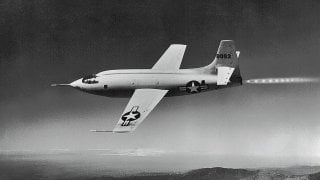Bell X-1: The First Plane to Hit Mach 1 (And Changed The Game)
The X-1 program became the template for future X-programs, like the X-15, X-20, and X-29. And data gathered from the X-1 flights deeply informed the development of future fighter jets. Today, you can find Glamorous Glennis on display at the National Air & Space Museum in Washington, D.C. Or, you can watch a depiction of Yeager’s historic flight in The Right Stuff (1983).
Today, the X-1 might seem like an old and antiquated plane when stacked up against the latest and greatest combat aircraft and bombers the U.S. air force has right now. However, this plane's place in aviation history is secure for countless reasons:
Breaking the sound barrier has become commonplace. Fighter jets, bombers, and even a now-defunct commercial jet have crossed over to travel faster than the speed of sound. Yet eighty years ago, the sound barrier was a province of flight reserved solely for the most cutting edge, daring, experimental airframes – the X-series. Whether the sound barrier could be broken at all remained unproven.
Skeptics maintained that the threshold simply could not be crossed, or that crossing that barrier would cause an aircraft to combust. The sound barrier loomed large in the minds of aerospace designers, as a major milestone with psychological significance.
Intent on being the first to break the sound barrier, NACA (NASA’s predecessor), the U.S. Air Force, and the U.S. Army Air Force jointly commissioned Bell to create the first-ever X-plane, a now mythical airframe, the Bell X-1.
Bell X-1: Built to Burst Boundaries
The X-1 was designed in the mid-40s and built in 1945. The jet was built around a Reaction Motors XLR11 rocket engine that featured four chambers. The XLR11 burned ethyl alcohol diluted with water using a liquid oxygen oxidizer. The engine’s four chambers could be turned on or off individually, giving the pilot precise control over the thrust. Each chamber provided 1,500 pounds of thrust.
Bell’s Jack Woolams was the first person to ever fly the X-1. He made several glide-flights in Florida after being dropped from a B-29 at 29,000 feet. Using data gathered from Woolams’ test flights, Bell made further modifications in preparation for powered flight.
The Power of Flight
The first powered X-1 flight occurred in the last month of 1946. Chalmers “Slick” Goodlin replaced Woolams, who had died practicing for the National Air Races. During the test flight, Goodlin lit only two of the engine’s chambers, but the jet still accelerated so quickly that one was turned off until the X-1 could climb to 35,000 feet. At 35,000 feet, two chambers were tested and the X-1 reached Mach 0.795. Tests continued at a cautious pace while the X-1’s systems were verified. The X-1 wouldn’t break the sound barrier until its 50th flight.
With Goodlin demanding a $150,000 (or, $1.82 million in 2022) bonus for breaking the sound barrier, Chuck Yeager stepped in to see if he couldn’t edge the X-1 past the sound barrier. Flying for just his Air Force base pay, Yeager took X-1 #46-062, nicknamed Glamorous Glennis for his wife, to see whether breaking the sound barrier was possible at all.
On October 14, 1947, Yeager and Glamorous Glennis were dropped from the bomb bay of a B-29. Igniting all four of the X-1’s engine chambers, Yeager became the first person to ever break the sound barrier; he reached Mach 1.06, or 700 miles per hour, proving definitively that the sound barrier was indeed breakable. The U.S. military had hoped to keep the news of their scientific breakthrough a secret but without much luck. Aviation Week and the Los Angeles Times scooped the secret story. When the publications ran headlines about Yeager’s historic flight, the Air Force threatened legal action, although no suit was ever filed. The news shocked the world.
The X-1 program became the template for future X-programs, like the X-15, X-20, and X-29. And data gathered from the X-1 flights deeply informed the development of future fighter jets. Today, you can find Glamorous Glennis on display at the National Air & Space Museum in Washington, D.C. Or, you can watch a depiction of Yeager’s historic flight in The Right Stuff (1983).
About the Author: Harrison Kass
Harrison Kass is the Senior Defense Editor at 19FortyFive. An attorney, pilot, guitarist, and minor pro hockey player, he joined the US Air Force as a Pilot Trainee but was medically discharged. Harrison has degrees from Lake Forest College, the University of Oregon, and New York University. He lives in Oregon and listens to Dokken. Follow him on Twitter @harrison_kass. Email the Author: [email protected].


